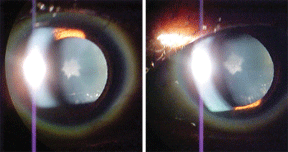 History
History
A 45-year-old black female presented for a routine eye examination. She had no ocular complaints, signs or symptoms.
Her systemic history was remarkable for depression; she has used various anti-depression medications for nearly 20 years. However, she reported no additional systemic conditions or medications.
Diagnostic Data
Her best-corrected visual acuity was 20/25 O.U. at distance and near. External examination was normal, and there was no evidence of afferent pupillary defect.
The pertinent anterior segment observations are illustrated in the photographs.
Intraocular pressure measured 19mm Hg O.U. The dilated fundus findings were normal O.U.

Biomicroscopy images (O.D. left, O.S. right) of a 45-year-old female patient who reported continuous use of anti-depression medications for nearly 20 years.
Your Diagnosis
How would you approach this case? Does this patient require any additional tests? What is your diagnosis? How would you manage this patient? Whats the likely prognosis?
Discussion
The diagnosis in this case is anterior subcapsular cataracts secondary to chronic exposure to an array of oral medications used to treat depression over a 20-year period.
Additional tests could include laser interferometry to assess the maximum potential for foveal acuity as well as visual field and glare testing to rule out functional deficits.
The cellular and ultrastructural changes that affect the layers of the lens produce fiber disorganization and medial opacity.1-5 In the lens epithelium, degenerative changes and vacuolization produce both anterior and posterior subcapsular cataracts.1-5 Ultrastructurally, the cytoplasmic density within the lens fibers becomes variable, resulting in convolution and distortion of the fiber membranes.1
Specifically, anterior subcapsular cataracts appear to be caused by a metaplastic change in central lens epithelium.1 The cells become elongated, spindle-shaped and myofibroblast-like.1 In subcapsular cataracts, fluids move passively to enter the lens capsule externally.6 This initially forms numerous free, clear-grey, subcapsular fluid vacuoles.6 When the ion pump, which serves as a metabolic barrier, becomes severely damaged, other fluids may also enter the lens. These fluids move inward as deep as the nucleus and produce secondary nuclear cataracts.6
Generally, no major histologic changes occur during the development of nuclear cataracts. Here, light scatter is induced secondary to the accumulation of high molecular weight protein as the nucleus becomes yellow-brown and compacted.1,4,5
Systemic diseases and pharmacologic exposures are known to produce a multitude of lens opacities.1-6
1. Sugar A. Conjunctival and corneal degenerations: Salzmanns corneal degeneration. In: Yanoff M, Duker JS (eds). Ophthalmology.
2. McCarty CA, Wood CA, Fu CL, et al. Schizophrenia, psychotropic medication and cataract. Ophthalmology 1999 Apr;106(4):683-7.
3. Li J, Tripathi RC, Tripathi BJ. Drug-induced ocular disorders. Drug Saf 2008;31(2):127-41.
4. Marder SR, Essock SM, Miller AL, et al. Physical health monitoring of patients with schizophrenia. Am J Psychiatry 2004 Aug;161(8):1334-49.
5. Ohia SE,
6. Pau H. Cortical and subcapsular cataracts: significance of physical forces. Ophthalmologica 2006;220(1):1-5.

